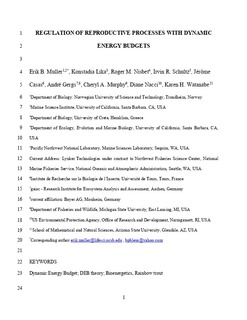| dc.description.abstract | Linking organismal‐level processes to underlying suborganismal mechanisms at the molecular, cellular and organ level constitutes a major challenge for predictive ecological risk assessments. This challenge can be addressed with the simple bio-energetic models in the family of dynamic energy budget (DEB), which consist of a small number of state equations quantifying universal processes, such as feed-ing, maintenance, development, reproduction and growth.2. Motivated by the need for process‐based models to evaluate the impact of endo-crine disruptors on ecologically relevant endpoints, this paper develops and evalu-ates two general modelling modules describing demand‐driven feedbackmechanisms within the DEB modelling framework exerted by gonads on the allo-cation of resources to production of reproductive matter.3. These modules describe iteroparous, semelparous and batch‐mode reproductive strategies. The modules have a generic form with both positive and negative feed-back components; species‐ and sex‐specific attributes of endocrine regulation can be added without changing the core of the modules.4. We demonstrate that these modules successfully describe time‐resolved meas-urements of wet weight of body, ovaries and liver, egg diameter and plasma con-tent of vitellogenin and oestradiol in rainbow trout (Oncorynchus mykiss) by fitting these models to published and new data, which require the estimation of less than two parameters per data type.5. We illustrate the general applicability of the concept of demand‐driven allocationof resources to reproduction by evaluating one of the modules with data on growth and seed production of an annual plant, the common bean (Phaseolisvulgaris). | nb_NO |
